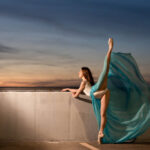Noel Streatfeild, renowned for her charming tales of children navigating the performing arts in books like Ballet Shoes and Theater Shoes, returns to a familiar stage with Dancing Shoes. This novel, set in a dance school run by the demanding and self-centered Cora Wintle, introduces us to a new cast of young hopefuls, “Wintle’s Wonders.” At the heart of the story are Rachel, Cora’s niece, and her adopted sister Hilary. Orphaned after their mother’s passing, the girls find themselves under Cora’s roof. While Rachel harbors no passion for dance, Hilary possesses a genuine talent, echoing their mother’s wish for her to attend the prestigious Royal Ballet School. Rachel, concerned about the quality of Hilary’s training under Mrs. Wintle, observes the school with a critical eye. Adding to their challenges is the blatant favoritism Cora displays towards her own spoiled daughter, Dulcie.
Having enjoyed Streatfeild’s previous works immensely, particularly when brought to life by Elizabeth Sastre’s narration, Dancing Shoes felt like a slightly less enchanting performance compared to its “shoes” predecessors. The narrative structure mirrored Ballet Shoes and Theater Shoes quite closely, and the characters, while engaging, didn’t resonate as deeply as the Fossils or the Forbes children. Cora Wintle, in her role as the antagonist, bordered on caricature, and Rachel’s motivations for hindering Hilary’s “Wonder” aspirations felt somewhat unconvincing. Supporting characters like Pursey, the girls’ nurse, and Mrs. Storm, their teacher, seemed like paler imitations of beloved figures from earlier books, such as Nana and Doctor Jakes and Doctor Smith. Dulcie, too, lacked dimension, yearning for a redeeming trait to soften her spoiled persona.
However, Dancing Shoes presented an intriguing sense of modernity that distinguished it from the earlier books. Published in 1957, alongside enduring classics like Beverly Cleary’s Henry and Ribsy and Dr. Seuss’s The Cat in the Hat, the story, aside from a few dated references, possesses a timeless quality. In fact, contemporary readers of middle grade fiction might find the dynamic between Rachel, Hilary, and Dulcie surprisingly familiar, echoing the “mean girls” narratives prevalent in 21st-century tween literature. This unexpected relevance could make Dancing Shoes an easier sell to modern young readers compared to its more traditionally styled “shoes” counterparts.
Regrettably, this marks the final Streatfeild audiobook available, at least in this reader’s experience. While Dancing Shoes may not have reached the heights of enjoyment of the other “shoes” books, the prospect of no longer hearing Elizabeth Sastre’s captivating voice, which has become synonymous with Streatfeild’s characters, is genuinely disappointing.

